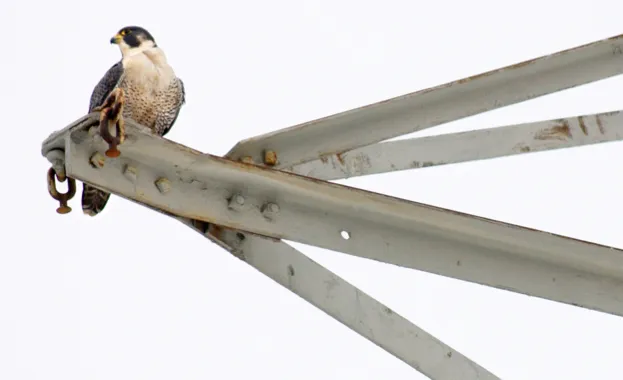A male peregrine falcon comes screaming out of the afternoon sun. Moments before a lesser black-backed gull pounces on its young, the world’s fastest bird hurtles from the sky with all the wrath of a protective parent. The gull turns in mid-air, falling backwards with its webbed feet and snapping bill facing its attacker. The pair engage and release in a fraction of a second.
It’s a minor skirmish in a long Cold War fought on sea cliffs around the world: two birds at the pinnacle of the food-chain reminding one another of their strengths. But the whole episode plays out far from any cliff or coastline, high on the Victorian steeple of St John’s Church in the historic city of Bath.
“An urban existence is now the norm for peregrines in much of England,” says local ecologist David Goode. “Especially in the south, where there are relatively few suitable inland cliffs as breeding sites.” By colonising city centres, a raptor that was driven almost to extinction in England by the 1960s has been able to expand its range and population significantly as the threats of persecution and pesticide-poisoning recede.
Urban peregrines are one of the more eye-catching examples of a quiet insurrection taking place in our cities and towns. Across the world, in places once thought to be almost sterile, scientists are finding species that are not just surviving, but adapting and thriving.

Peregrine falcons have adapted to city living © John Ewing / Portland Press Herald / Getty
Peregrine pioneers
It is possible that a single pair sparked the momentous shift, says Goode. The first peregrines known to have moved into a city centre began nesting on Swansea’s Guildhall in the 1980s. “When young birds hatched in a city disperse to establish territories of their own, they’re not looking for a cliff any more,” he says, adding that before long every major city and town in Britain will have peregrines. Cathedral and church towers, office blocks and shopping centres all make ideal nest sites. In London alone 24 pairs nest on city landmarks, including the Houses of Parliament.
“This is a really strong example of Darwinian adaptation,” says Goode. And the same behavioural shift has occurred in mainland Europe and the USA. The city of Portland, which occupies just 0.1 per cent of Oregon’s land area, houses 10 per cent of its peregrine nests, making the conurbation just as much the falcon’s state capital as it is the people’s.
The peregrines not only use a city’s architecture, but also its nightly glow – after dusk lights illuminate a wealth of new targets for the falcons’ mid-air predation. Redwings, fieldfares, starlings, woodcocks and many other nocturnal migrants winging their way through the British night have never known night-time hunters such as these. Dismembered bills, feet and wing-parts scattered on urban pavements across Britain indicate that the peregrines are feasting on their ignorance.
Karl Mathiesen is an environment and science journalist.
This is an abbreviated version of an article that first appeared in the August 2015 issue of BBC Wildlife Magazine.
Is urban living bad for birds? Mike Toms of the British Trust for Ornithology enlightens...
Roughly one in five of the world’s bird species is found in cities, prompting research into the effects of urban living. Generalists, omnivorous in diet, tend to adapt to urban environments better than those with specialist requirements. But even within these species, there are indications that cities may not be good for birds’ health.
Researchers have found evidence that urban populations suffer from higher levels of oxidative stress compared to individuals elsewhere, which negatively impacts their health. Recently, attention has been focussed on ‘telomeres’ – the nucleoprotein structures found at the end of chromosomes. These promote genome stability, and there is evidence associating telomere length with lifespan and mortality rate.
If the pressures of urban living modify an individual’s oxidative balance, then this may result in shortened telomeres – something that has been found in urban great tits and blackbirds. But such health costs need to be set against all the possible benefits – for instance, the availability of food at garden feeding-stations.